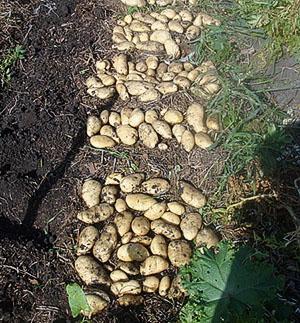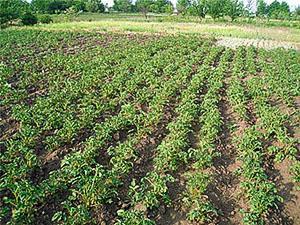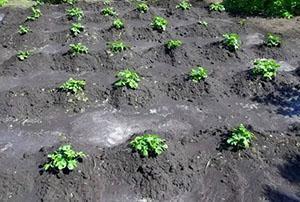Why spud potatoes?
 The answer to it will become clear after considering the vegetative characteristics of this crop. In potatoes, below soil level, relatively rapidly dying elongated side shoots, called stolons, develop. They have elongated internodes, axillary buds, and underdeveloped leaves. On the stolons, shortened shoots develop, which are the potato tubers. About, when to spud potatoes, read here!
The answer to it will become clear after considering the vegetative characteristics of this crop. In potatoes, below soil level, relatively rapidly dying elongated side shoots, called stolons, develop. They have elongated internodes, axillary buds, and underdeveloped leaves. On the stolons, shortened shoots develop, which are the potato tubers. About, when to spud potatoes, read here!
Reasons for spilling potatoes

- Most often, hilling of potatoes is carried out in order to obtain a large number of additional lateral shoots - stolons, on which tubers are formed. With regular hilling of plants, the bushes actively grow and become more powerful. In this case, the tubers are tied on a larger number of stolons, and the significant leaf mass of the plant contributes to the supply of a sufficient amount of nutrients to the lower sections, which also leads to an increase in yield.
- Another important reason for hilling potatoes is the protection of young plants from late frosts. This event is especially relevant when potatoes are planted early or cultivated in climatic zones with an unstable climate. The land forming mounds around young potato stalks serves as a kind of "blanket" for them. Hilling also protects vulnerable young shoots from sudden frost, allowing them to actively develop further.
- The high mounds around the potatoes prevent strong winds from breaking and bending the stems of the plants, which also has a beneficial effect on increasing yields.
 Some gardeners who prefer to plant this crop "under a shovel" are wondering whether it is necessary to spud potatoes in this case, because the bulk of the lower part of the plant is deep in the ground. Hilling not only contributes to the formation of more stolons, it improves the structure of the soil, making it looser and more breathable. This is especially true when growing potatoes on dense and moist soils.
Some gardeners who prefer to plant this crop "under a shovel" are wondering whether it is necessary to spud potatoes in this case, because the bulk of the lower part of the plant is deep in the ground. Hilling not only contributes to the formation of more stolons, it improves the structure of the soil, making it looser and more breathable. This is especially true when growing potatoes on dense and moist soils.- The procedure allows water, when irrigated or rained, to penetrate more quickly to the underground organs of the plant, which helps them to obtain a sufficient amount of moisture.
- Hilling potatoes helps to reduce weeds in potato plantings. This is especially true of such a plant as creeping wheatgrass, which, if removed in time by its roots, can even penetrate into young tubers, violating their market value.
- With shallow planting and regular hilling of potatoes during harvest, it is easier to dig up the tubers, since this does not require "burying" deep into the ground. Thus, the procedure for collecting tubers becomes less labor-intensive.
- Furrows, ridges and simple rows of spud potatoes are much easier to process with products designed to kill harmful insects such as the Colorado potato beetle.
- Hilled potato plantings are easier to process with various cultivators and other agricultural equipment.
How and how many times to hilling?
 Many novice gardeners do not know how to huddle potatoes.The video clearly demonstrates that this procedure can be performed in a variety of ways. The most popular ones are:
Many novice gardeners do not know how to huddle potatoes.The video clearly demonstrates that this procedure can be performed in a variety of ways. The most popular ones are:
- Hilling with a hoe or hoe. This method is applicable in the event that the area of the site occupied by the plantings of this crop is not too significant.
- Hilling with cultivator... With this practical agricultural technique, large potato plantings can be cultivated.
 Hilling with a mini tractor is an ideal option for small farms where quite large areas of land are allocated for potatoes.
Hilling with a mini tractor is an ideal option for small farms where quite large areas of land are allocated for potatoes.
When hilling potatoes, it should be remembered that active development of tubers occurs only when the air temperature is no more than 25 ° C. In this case, the soil should always be loose and moist. Otherwise, the yield will be very low, no matter how many times the gardener spuds the potatoes. That is why in dry and hot regions, where there is no possibility of regular watering, hilling is often abandoned altogether.
 How many times to spud potatoes? During the season, it is necessary to carry out this procedure at least 2 times. The first time it is performed when young plants have just emerged from the ground and have reached 5-10 cm in height. Re-hilling is performed when the stems reach a height of 15-20 cm and buds appear.
How many times to spud potatoes? During the season, it is necessary to carry out this procedure at least 2 times. The first time it is performed when young plants have just emerged from the ground and have reached 5-10 cm in height. Re-hilling is performed when the stems reach a height of 15-20 cm and buds appear.
Tilling potato beds is best done in the early morning or evening. Moreover, the soil must be moist. Ideally, the hilling of potatoes, after reaching 20 cm in height, is carried out every 2 weeks until its green mass on the site is closed.
The article covers all aspects of the need for hilling potatoes. When farming large areas on a farm, it is understandable that a mechanical method is indispensable. In personal farms, hilling is carried out in different ways. There is a method of planting potatoes in a square-nesting method and hilling each bush. But it seems to me that in a deep loose crest the tops of two bushes close together and feel comfortable. Often, when harvesting, you have to observe that the potatoes from a neighboring bush ran away to visit. With a square planting, there is more space for the development of a bush, but the mound is not high. The third time to rake with good development of the bush does not work, the stems interfere, are injured. Until the bush closes, I loosen the aisles with narrow pitchforks, but the roots will already settle there by this time. I tried to plant potatoes on the bayonet of a shovel in my loose soil without hilling. So, I got a mediocre harvest. I only dug a bucket from 6 bushes. It turns out that it is necessary to spud the bush twice.